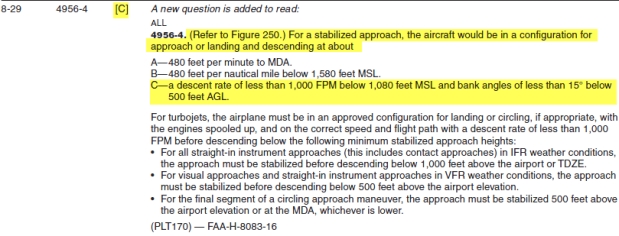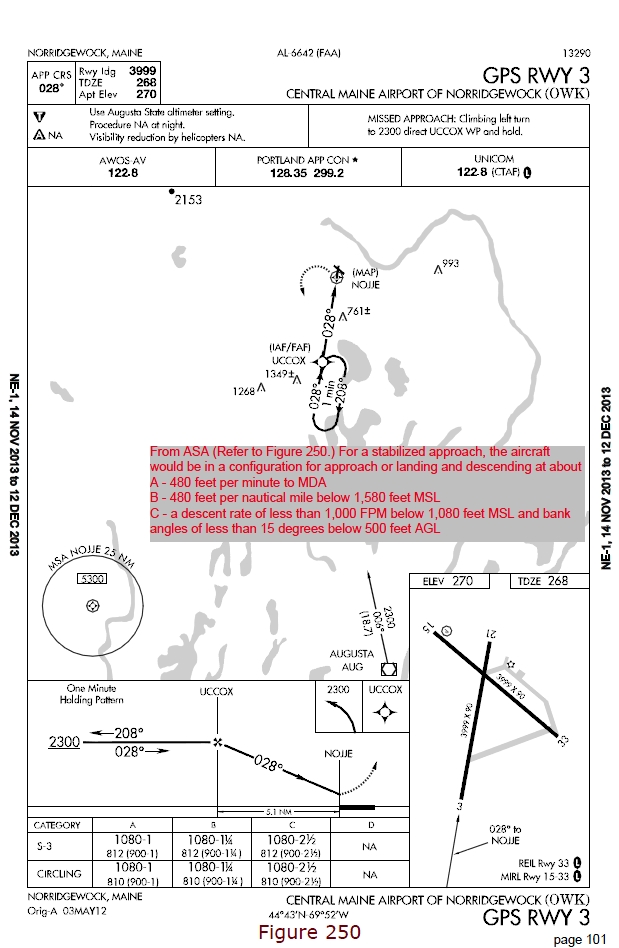eetrojan
Pattern Altitude
I'm preparing for the IR written (taking it in a week).
In some other thread, Bob Gardner referenced ASA's updates to its Test Prep Books. So, I went to his link and took a look with special interest in the new questions:
http://www.asa2fly.com/FAA-Knowledge-Exams-W22.aspx
According to ASA's update, the knowledge test has a new question, reproduced below, that is based on Figure 250 in the FAA's test book Addendum from 2/14, also reproduced below.
How does one reasonably get answer [c] out of the quoted language in ASA's explanation? In case it helps, it's from pages 4-36 to 4-37 of the Instrument Procedures Handbook.
I don't see anything on the plate, interpreted in light of ASA's explanation, that would get me 1,080 feet MSL.
I know that 1,080 is the MDA, but the bullet items in the explanation say that the approach must be "stabilized " before: (1) descending below 1,000 feet above the airport or TDZE (i.e. before descending below 1,270 [1000+Elev] or 1,268 [1000+TDZE]); or (2) descending below 500 feet above airport elevation (770); or lastly, (3) descending below 500 feet above airport elevation (770) or MDA (1080), whichever is less, meaning 770.
Why the heck are there so many different scenarios?
There's nothing in the explanation about bank angle and 500 AGL.
Is C correct only because A and B are wrong in the sense that 480 fpm is totally random, and therefore obviously wrong?
What are they trying to teach us here?
Thanks for your help!


In some other thread, Bob Gardner referenced ASA's updates to its Test Prep Books. So, I went to his link and took a look with special interest in the new questions:
http://www.asa2fly.com/FAA-Knowledge-Exams-W22.aspx
According to ASA's update, the knowledge test has a new question, reproduced below, that is based on Figure 250 in the FAA's test book Addendum from 2/14, also reproduced below.
How does one reasonably get answer [c] out of the quoted language in ASA's explanation? In case it helps, it's from pages 4-36 to 4-37 of the Instrument Procedures Handbook.
I don't see anything on the plate, interpreted in light of ASA's explanation, that would get me 1,080 feet MSL.
I know that 1,080 is the MDA, but the bullet items in the explanation say that the approach must be "stabilized " before: (1) descending below 1,000 feet above the airport or TDZE (i.e. before descending below 1,270 [1000+Elev] or 1,268 [1000+TDZE]); or (2) descending below 500 feet above airport elevation (770); or lastly, (3) descending below 500 feet above airport elevation (770) or MDA (1080), whichever is less, meaning 770.
Why the heck are there so many different scenarios?
There's nothing in the explanation about bank angle and 500 AGL.
Is C correct only because A and B are wrong in the sense that 480 fpm is totally random, and therefore obviously wrong?
What are they trying to teach us here?
Thanks for your help!


Last edited:
